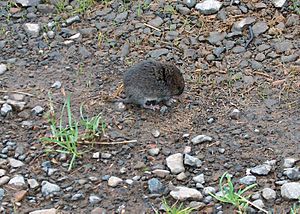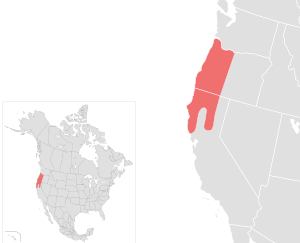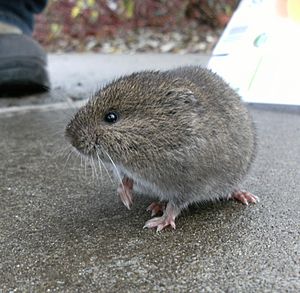Western red-backed vole facts for kids
Quick facts for kids Western red-backed vole |
|
|---|---|
 |
|
| Conservation status | |
| Scientific classification | |
| Genus: |
Myodes
|
| Species: |
californicus
|
 |
|
| Distribution of the Western red-backed vole | |
| Synonyms | |
|
|
The western red-backed vole (Myodes californicus) is a small rodent that lives in California and Oregon in the United States. It is a type of vole, which is a small mouse-like animal. These voles mostly live in coniferous forests, which are forests with trees like pines and firs.
This vole has a reddish-brown or brown body with some black hairs. Its sides are lighter, turning into a buffy-gray color on its belly. It has a faint reddish stripe on its back. Its tail is two colors and is about half as long as its head and body.
Contents
About the Western Red-Backed Vole
The western red-backed vole was first described by a scientist named C. Hart Merriam in 1890. He gave it the scientific name Evotomys californicus. The first example of this animal studied by scientists was an adult male. It was found near Eureka, California, in 1889.
What Does It Look Like?
The western red-backed vole is usually between 121 to 165 millimeters (about 4.8 to 6.5 inches) long from its nose to the tip of its tail. Its tail is about 34 to 56 millimeters (1.3 to 2.2 inches) long. Its hind foot is 17 to 21 millimeters (0.7 to 0.8 inches) long, and its ear is 10 to 14 millimeters (0.4 to 0.6 inches) long. The vole stands about 18 to 21 millimeters (0.7 to 0.87 inches) tall.
This vole is closely related to the southern red-backed vole (Myodes gapperi). The southern red-backed vole lives further north and east. It is usually redder and has a tail with more distinct two colors. The western red-backed vole can be told apart by the reddish stripe on its back. It also has some unique features in its skull.
Where It Lives and Its Home
The western red-backed vole is found in northern California and western Oregon in the United States. Its northern border is the Columbia River. Its range goes south to about 100 kilometers (60 miles) north of the San Francisco Bay. It lives from the tops of the Cascade Range mountains in the east all the way to the Pacific Ocean.
These voles mainly live in coniferous forests. They prefer areas that scientists call the Transition and Canadian life zones. These zones are described by the types of plants and animals that live there.
How It Behaves and Its Role in Nature
The western red-backed vole spends a lot of its time underground. It builds a large system of tunnels and burrows. It mostly eats special kinds of fungi that grow underground. These fungi are called mycorrhizal fungi. They have a special partnership, called symbiosis, with the trees in the forest.
One example is a fungus called Rhizopogon vinicolor, which grows with Douglas-fir trees. This fungus grows its fruiting bodies (like mushrooms, but underground) in old, decaying wood. The spores of these fungi are not released into the air. Instead, the vole eats the fungi, and the spores pass through its body. The vole then spreads the spores in its droppings throughout its burrows. This helps the fungus spread and connect with new trees.
Scientists have found that if a forest is completely cleared, and all the dead wood is removed, these fungi stop growing. Then, the vole population disappears, and new trees planted in the area don't grow well. This shows a cool three-way partnership:
- The vole gets food from the fungus.
- The fungus gets nutrients from the tree.
- The tree gets help from the fungus to grow.
- The vole helps spread the fungus's spores.
The western red-backed vole is an important part of the forest food web. It lives in old-growth forests and is a key food source for many other animals. For example, the northern spotted owl eats western red-backed voles a lot. These voles, along with red tree voles and northern flying squirrels, make up more than 75% of the spotted owl's diet.
The vole's diet can change depending on where it lives. Voles living in higher, colder places eat a wider variety of foods. This is different from what they eat in milder, lower areas.
Reproduction and Life Cycle
Western red-backed voles breed for most of the year in some areas. On the slopes of the Cascade Range in northern Oregon, they breed between February and November. To the west of the Cascade Range, they can breed all year long. A female vole usually has 2 to 7 young in each litter. The babies are born after about 18 days of pregnancy.
Voles and People
Conservation Status
The western red-backed vole is considered to be of "least concern" by the IUCN (International Union for Conservation of Nature). This means that there are no major threats to this animal. It is a common species and lives in a wide area.
How Voles Help Scientists
In some places, voles live close to industrial areas. Scientists use these voles to check for pollution in the environment. They look for harmful chemicals called persistent organic pollutants (POPs), like PCBs. These chemicals can build up in the vole's fatty tissues. By studying the voles, scientists can learn about how much pollution is in the environment.
See also
 In Spanish: Myodes californicus para niños
In Spanish: Myodes californicus para niños



